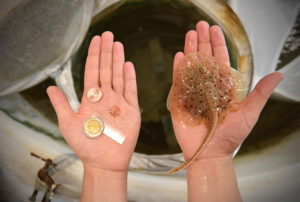
Meet the Robotic Stingrays Made with Rat Heart, Algae, and Plastic Fins
Meet the Robotic Stingrays Made with Rat Heart, Algae, and Plastic Fins
Scientists control the bionic fish with light.
Scientists have built a robotic stingray made of heart muscle cells from a rat, a skeleton of gold, plastic fins, and light-activated algae proteins—because, why not?
Sung-Jin Park led the project, which is described today in the journal Science. He says the tiny, 16-millimeter-long robots take about a week to make, mostly because of the time it takes to grow the heart muscle cells in the stingray mold. Park is a scientist in Kevin Kit Parker’s lab at Harvard University, which four years ago made a biohybrid jellyfish robot. “The jellyfish was impossible to control,” Park says, a challenge he overcame with the comparatively agile stingray.
The robotic stingray is propelled forward when stimulated with bursts of LED light. Sung-Jin Park and colleagues modeled their biohybrid robot after the undulating movement of the little skate seen here.
Rays are “an ideal blueprint” for the next generation of autonomous underwater vehicles, says Keith Moored, a mechanical engineer from Lehigh University in Bethlehem, Pennsylvania. Manta rays are very efficient swimmers, Moored says, and modeling their underwater gliding could provide a promising means for conserving energy. Park’s robot is based on a different ray species, but the same principles apply.
The robotic stingrays are made in four layers on a titanium mold. A stretchy polymer layer is laser cut into the stingray shape, followed by a thin gold skeleton. This is covered with a second stretchy layer before the heart muscle cells are seeded.
When the heart muscle cells are activated, the signal to contract spreads down the cells in a line. Park aligned the cells he obtained from a rat heart in a serpentine zig-zag pattern along the fins of the stingray. This allows the fins to move in wavelike undulations as the contraction spreads from front to rear.
Of course, the robotic stingray is not a perfect replica of the real deal. The robot’s muscles can only contract downward. Actual stingrays have a second muscle layer for big upstrokes, while the robot uses the elastic energy of the gold skeleton to move its fins back in place. “That’s why we think there is a performance gap, and adding a second layer might close that gap,” Park says.
The muscles are controlled via light through a technique known as optogenetics. Here, the gene for a protein derived from algae is inserted into the muscle cells. Blue light causes this protein to activate the muscle tissue.
This sort of biobot has been made before, but Park’s stingray shows greater maneuverability. Park guided the robot with LED lights through a simple obstacle course, showing that the stingray outperforms other biohybrid robots in speed, distance, and durability. Still, the stingrays are not exactly Olympic swimmers, traveling only 1.5 millimeters per second in a 250-millimeter obstacle course.
As for why anyone would want a little robotic stingray, Park says he is simply “interested in the biological model, making these circuits, and designing a signaling pathway.” Developing models for how engineered heart tissue contracts may also aid in developing future artificial organs.
Moored says that using real biological muscles can lead to “an exceptionally quiet noise signature” compared to other technologies. “This is important for a range of applications from producing stealthy reconnaissance vehicles to developing devices that can noninvasively track species and observe their behaviors,” he says.

 The soft robotic stingray (left) was modeled after the little skate, Leucoraja erinacea (right), at one-tenth scale.
The soft robotic stingray (left) was modeled after the little skate, Leucoraja erinacea (right), at one-tenth scale. About 200,000 heart muscle cells obtained from a rat move the gold skeleton and polymer fins of the robotic stingray.
About 200,000 heart muscle cells obtained from a rat move the gold skeleton and polymer fins of the robotic stingray.
Leave a Reply